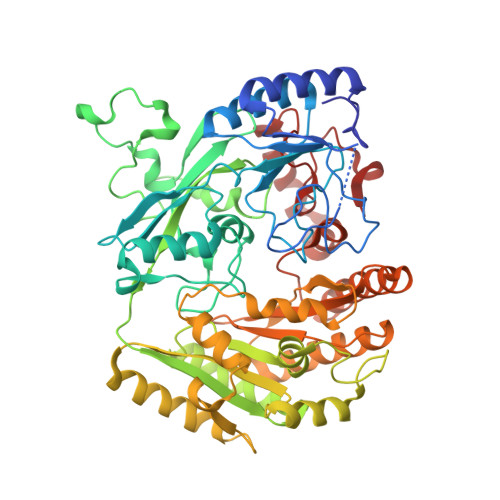Laboratory-Evolved Vanillyl-Alcohol Oxidase Produces Natural Vanillin
Van Den Heuvel, R.H., Van Den Berg, W.A., Rovida, S., Van Berkel, W.J.(2004) J Biol Chem 279: 33492
- PubMed: 15169773
- DOI: https://doi.org/10.1074/jbc.M312968200
- Primary Citation of Related Structures:
1W1J, 1W1K, 1W1L, 1W1M - PubMed Abstract:
The flavoenzyme vanillyl-alcohol oxidase was subjected to random mutagenesis to generate mutants with enhanced reactivity to creosol (2-methoxy-4-methylphenol). The vanillyl-alcohol oxidase-mediated conversion of creosol proceeds via a two-step process in which the initially formed vanillyl alcohol (4-hydroxy-3-methoxybenzyl alcohol) is oxidized to the widely used flavor compound vanillin (4-hydroxy-3-methoxybenzaldehyde). The first step of this reaction is extremely slow due to the formation of a covalent FAD N-5-creosol adduct. After a single round of error-prone PCR, seven mutants were generated with increased reactivity to creosol. The single-point mutants I238T, F454Y, E502G, and T505S showed an up to 40-fold increase in catalytic efficiency (kcat/Km) with creosol compared with the wild-type enzyme. This enhanced reactivity was due to a lower stability of the covalent flavin-substrate adduct, thereby promoting vanillin formation. The catalytic efficiencies of the mutants were also enhanced for other ortho-substituted 4-methylphenols, but not for p-cresol (4-methylphenol). The replaced amino acid residues are not located within a distance of direct interaction with the substrate, and the determined three-dimensional structures of the mutant enzymes are highly similar to that of the wild-type enzyme. These results clearly show the importance of remote residues, not readily predicted by rational design, for the substrate specificity of enzymes.
Organizational Affiliation:
Department of Genetics and Microbiology, University of Pavia, via Abbiategrasso 207, 27100 Pavia, Italy.
















